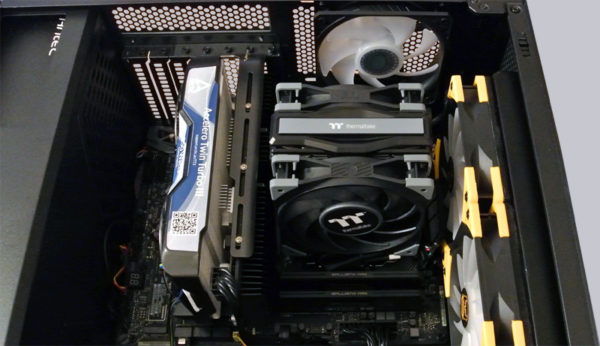
Test setup and results …
Before we get to the measurement results, let’s first start with the components in our test system and then take a look at the measurement procedure.
The test system is structured as follows:
| Operating system | Microsoft Windows 10 20H2 |
| CPU | AMD Ryzen 7 3700X |
| RAM | 2x 8GB Crucial Ballistix MAX DDR4-4400 @ 3600 MHz |
| Mainboard | ASRock Fatal1ty X470 Gaming K4 |
| Graphics card | Palit GeForce 1070Ti 8GB PCIe 3.0 Graphics Card |
| SSD | Samsung M2 SSD 256GB |
| Case | Cooler Master Masterbox 540 |
| Power supply | Antec HCG 750W |
The test course is composed as follows:
The CPU is loaded via AIDA64 (version: 6.33.5700) and the stability test “CPU” as well as “FPU” for 30 minutes. Afterwards, the core temperature is read out via HWInfo64 (version 5.82). Of course, we also measure the idle temperature via HWInfo64 before each test. The whole thing takes place in a closed case, and four 12cm case fans with 500 rpm provide sufficient case ventilation.
We also performed this test with the AMD Wraith Spire so that we can better assess the cooling performance of the cooler. The tests were performed with the fan setting Standard and Silent of the UEFI.
The room temperature was around 22 °C at the time of the tests, and the CPU was not overclocked and PBO was deactivated in the AMD CBS. In order not to keep you waiting any longer, here are the results of our measurements:
Here you can see how the Toughair 510 performs with the default fan profile of the ASRock UEFI. This scenario most closely matches full load operation in normal applications. The Toughair 510 can clearly stand out from AMD’s Wraith Prism here and keeps the CPU at a smooth 65°C with slightly noticeable noise. The fan speed was 1650 rpm in 8-core mode, whereas the Wraith Prism needed 2600 rpm.
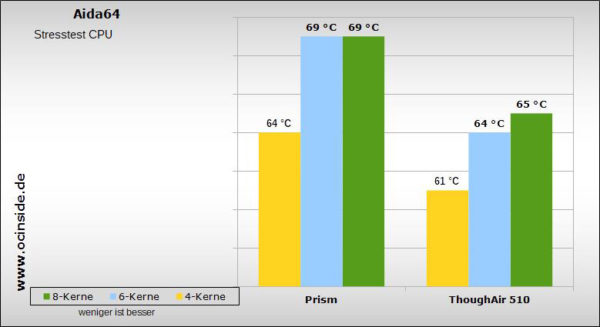
If you add the FPU test, things look different. The Toughair 510 can just about keep the X3700 in check. The AMD Wraith Prism, on the other hand, fails at least in 8-core operation, since the CPU starts throttling at 94°C. In terms of fan speed, the Toughair 510 ran at 2100 rpm and the Wraith Prism at 2900 rpm.
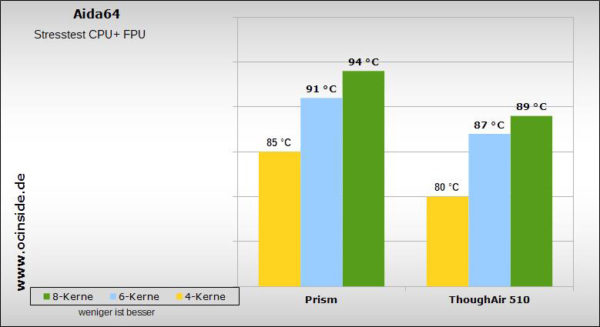
In the Silent profile we see a similar picture as in the Standard profile, Thermaltake’s cooler also clearly outperforms AMD’s boxed cooler here. The fan speed here is 1350 rpm, the Wraith Prism 2450 rpm.
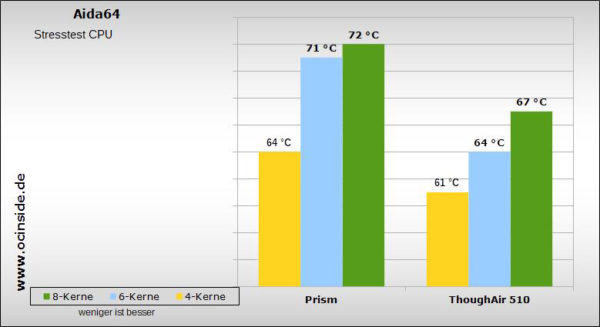
The situation is similar when the FPU test is added. The temperature can also be kept at about 90°C here. However, this is due to the fact that the full 2100 rpm is also applied here.
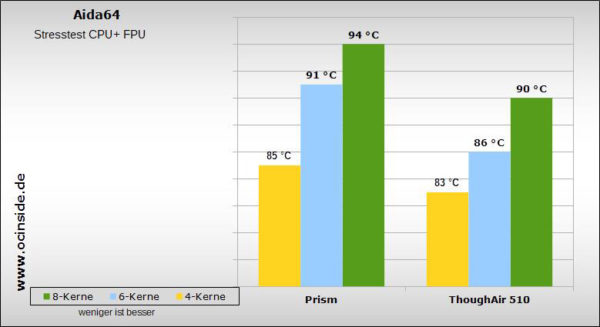
As mentioned at the beginning, Thermaltake uses direct heatpipe cooling for the Toughair 510, which means that there is no solid copper or nickel contact surface. Thus, the heatpipes have direct contact to the heatspreader of the CPU instead of being heated evenly over the otherwise existing contact surface. By the way, this is also the case with AMD’s Wraith Prism. If the processor DIE is not positioned centrally under the heatspreader (as was the case with our AMD Ryzen 7 3700X), this can lead to not all heatpipes being heated evenly and thus the maximum possible cooling performance decreases.
Regarding the noise, you can find an overview here, at which fan speed we could measure which dbA. Here you can also see quite well that the 23.6 dbA specified by Thermaltake can only be met when the fans are operated at a maximum of 1000 rpm.

Nevertheless, the Thermaltake Toughair 510 is significantly quieter than the AMD Wraith Spire in every situation. A bit of fine-tuning in the fan profile can save quite a bit of noise in everyday use.
Thermaltake Toughair 510 Result and general impression …


